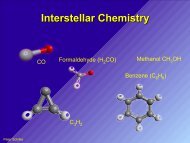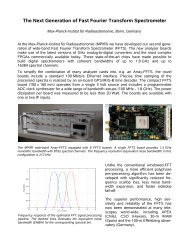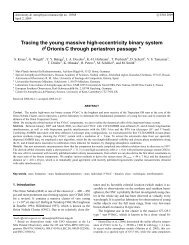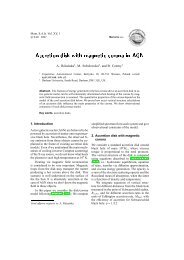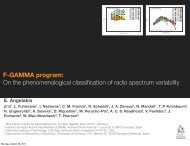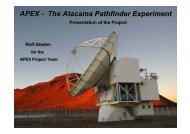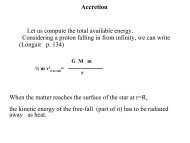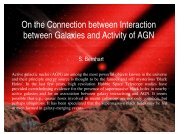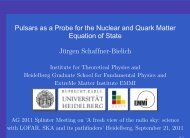Theoretical HDO emission from low-mass protostellar envelopes
Theoretical HDO emission from low-mass protostellar envelopes
Theoretical HDO emission from low-mass protostellar envelopes
- No tags were found...
You also want an ePaper? Increase the reach of your titles
YUMPU automatically turns print PDFs into web optimized ePapers that Google loves.
172 B. Parise et al.: Models of <strong>HDO</strong> <strong>emission</strong>ii)These molecules are not observed in the cold gas withlarge abundances measured in the inner regions of the<strong>envelopes</strong> surrounding solar-type protostars. Indeed,they are direct and indirect products of the grain mantleevaporation, so that they are linked to the pre-collapsephase.Deuterated molecules observed with extremely large abundances,which can only be formed during the cold, denseand CO depleted phase of the pre-collapse (Roberts &Millar 2000; Roberts et al. 2003). Notable examples areformaldehyde (Ceccarelli et al. 1998), methanol (Pariseet al. 2002, 2004), hydrogenated sulfide (Vastel et al. 2003)and ammonia (Lis et al. 2002; van der Tak et al. 2002).<strong>HDO</strong> belongs to the second class of molecules, signs of thepast pre-collapse phase. The above-mentioned moleculesshow extremely large deuteration ratios in <strong>low</strong> <strong>mass</strong> starformingregions: singly deuterated molecules are morethan 10% of their H-counterparts, whereas doubly andtriply deuterated molecules can respectively be as highas 10% and ∼1%. On the contrary, <strong>HDO</strong> is only a relativelysmall fraction of H 2 O, about 3% at best (Parise et al. 2005),andnoD 2 O has been detected so far, at relatively <strong>low</strong> upperlimits to our knowledge (Cernicharo, private communication).The above relative small values agree with thenon-detection of solid <strong>HDO</strong> in protostars (e.g. Dartoiset al. 2003; Parise et al. 2003). Thus, there is evidencethat water deuteration fol<strong>low</strong>s a different route with respectto the other molecules. In addition, the study of theavailable observations in IRAS 16293–2422 suggests thatthe deuteration ratio is not the same in the inner and outerenvelope: 3% and ≤0.2% in the inner and outer enveloperespectively (Parise et al. 2005). Thus, in order to better understandthis difference, one needs to be able to disentanglewhere the different <strong>emission</strong>s come <strong>from</strong>. The presentstudy aims at giving a theoretical tool for the estimate ofthe <strong>HDO</strong> abundance in <strong>protostellar</strong> <strong>envelopes</strong>, in the innerand outer regions, and, possibly, the evaporation temperature,and, consequently, at indicating the best observationsto obtain this information. Specifically, given that thesatellite HSO will be launched in 2007, particular care willbe devoted to discussing whether observations with instrumentson this satellite will be required to derive the <strong>HDO</strong>abundance and evaporation temperature in <strong>low</strong> <strong>mass</strong> <strong>protostellar</strong><strong>envelopes</strong>, compared to observations that can beobtained with ground based telescopes.The paper is organized as fol<strong>low</strong>s: we describe the adoptedmodel and code in Sect. 2, we present the <strong>HDO</strong> molecule aswell as the instruments available to observe its rotational spectrumin Sect. 3. We describe the general characteristics of thepredicted spectrum in Sect. 4 and give the results in Sect. 5for a relatively high (30 L ⊙ )and<strong>low</strong>(5L ⊙ ) luminosity case.Section 6 contains a discussion about the best lines to observeto derive the <strong>HDO</strong> abundance in the inner and outer envelope,as well as the <strong>HDO</strong> ice evaporation temperature. We also discussthe interest of carrying out space-based versus groundbased<strong>HDO</strong> observations to constrain these parameters.2. The model descriptionThe model used to compute the <strong>HDO</strong> <strong>emission</strong> in collapsing<strong>envelopes</strong> has been adapted <strong>from</strong> the original model developedby CHT96 to predict the OI, CO and H 2 O line <strong>emission</strong>,and successively modified to compute the H 2 CO line <strong>emission</strong>(Ceccarelli et al. 2003). Here we describe the basic assumptionsof the model.The envelope density structure and dynamics are assumedto fol<strong>low</strong> the “inside-out” collapse picture (Shu 1977), for aspherical initial isothermal sphere undergoing collapse. In theouter envelope, not yet affected by the collapse, the molecularhydrogen number density distribution n H2 (r) is given by:n H2 (r) =a 22πµm H G r−2( ) 2= 2.8 × 10 8 ar −20.35 km s −1 100 AU cm−3 (1)where a is the sound speed, m H is the hydrogen <strong>mass</strong>, µ is themean molecular <strong>mass</strong> in amu units, equal to 2.8, r 100 AU is thedistance <strong>from</strong> the center in 100 AU units, and G is the gravitationalconstant. In the inner collapsing regions the density isdescribed by the free-fall solution:n H2 (r) =(1 Ṁ 2 ) 12r− 3 24πµm H 2GM ⋆(2)= 1.2 × 10⎛⎜⎝7 Ṁ−52 ⎞ 12⎟⎠M ⋆ r100 3 AUcm −3 . (3)The free fall velocity is given:( ) 12GM⋆2v(r) =r( ) 1M⋆1 2= 4.2 km s −1 ,r 100 AU(4)where Ṁ is the <strong>mass</strong> accretion rate, related to the sound speedby( ) 3Ṁ = 0.975 a3G = a10−50.35 km s −1 M ⊙ yr −1 . (5)Ṁ −5 is Ṁ in units of 10 −5 M ⊙ yr −1 ,andM ⋆1 is the <strong>mass</strong> of thecentral object M ⋆ in units of 1 M ⊙ . The gravitational energyof the collapsed <strong>mass</strong> is released radiatively as material fallsonto the core radius R ⋆ , so that the luminosity of the centralobject is:L ⋆ = GM ⋆ṀR ⋆= 22( )M⋆M ⊙Ṁ −5 R −112 L ⊙ (6)where R 12 = R ⋆ /10 12 cm.The spherical symmetry is conserved throughout the collapsein this model. In this sense, the model gives accurate resultsonly for that part of the envelope in which spherical symmetryis a good approximation, i.e. probably for radii largerthan a few tens of AUs (Ceccarelli et al. 2000a). At smallerscales large deviations <strong>from</strong> the spherical symmetry are expectedbecause of the presence of a circumstellar disk.The gas temperature is computed self-consistently byequating the cooling and heating mechanisms at each point



